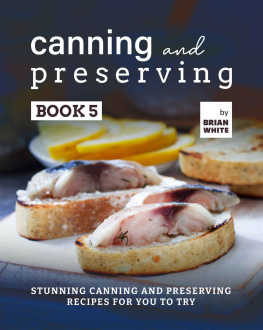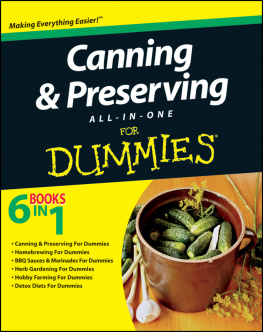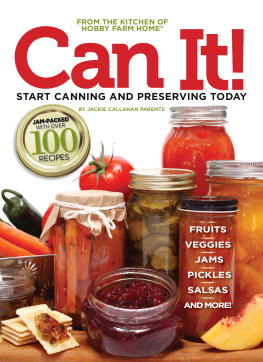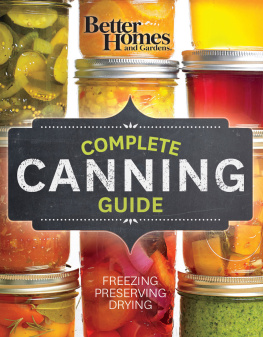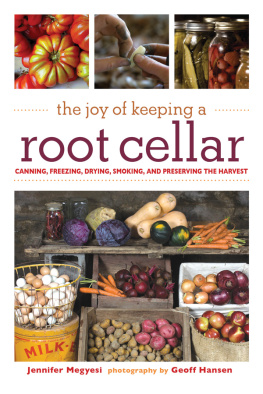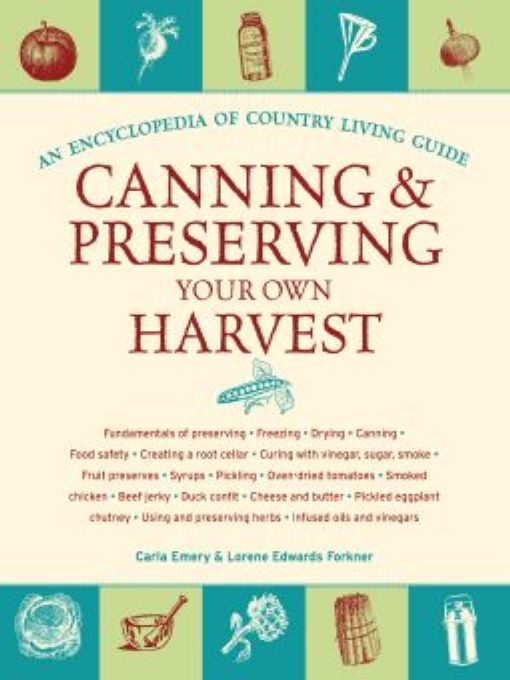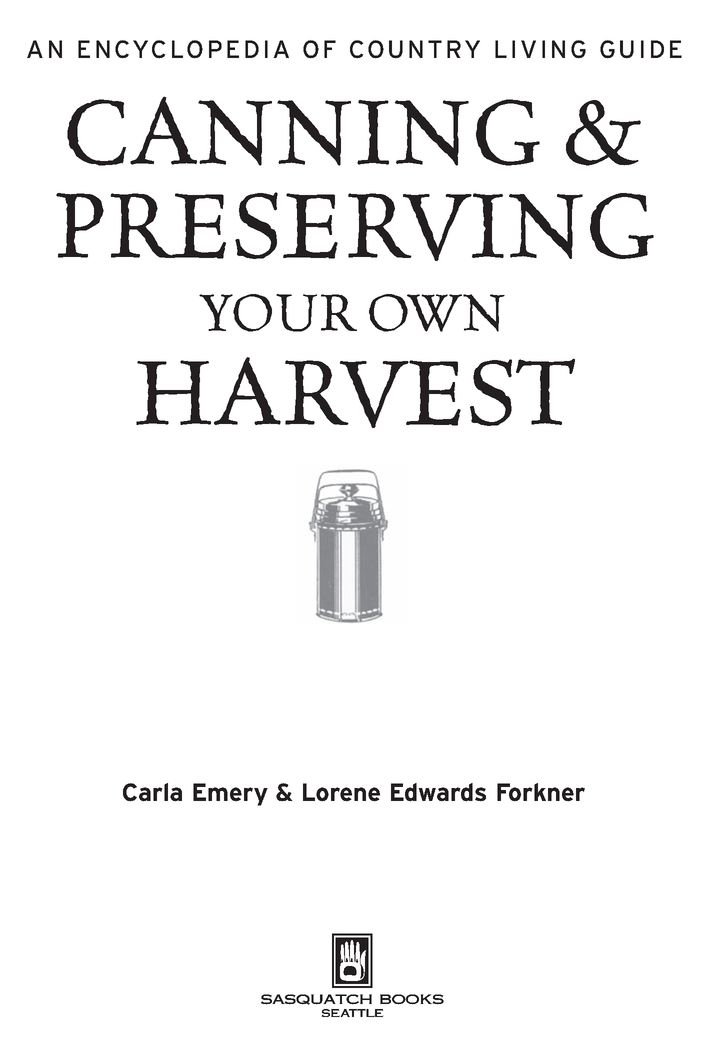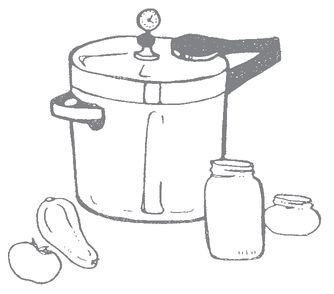Table of Contents
For all of us with fond memories of hot summer days picking blackberries, sticky kitchen counters, and glorious jamwhy is it so hard to get kids to pick berries these days?
LEF
INTRODUCTION
Today preserving is enjoying renewed popularity and extending the harvest is once again hip. Practices that began generations ago as sensible household economies have more recently become emblematic of resolute independence. At the middle of the twentieth century, many believed our country to be poised on the brink of nuclear war; fear was systemic and the world was a frightening place. The back-to-the-land movement, largely composed of disillusioned young adults, sought to withdraw from city life, with its many advances and perceived failed political systems, to seek a more self-sufficient lifestyle in an effort to survive the feared coming apocalypse. Nave? Perhaps. Resourceful? Most certainly. It was with this motivation that Carla Emery, her family, and many others like them moved to the country, where they began to rediscover the once-routine life skills of their grandparents and great-grandparents generations. Carla began keeping a record of these nearly lost country arts and practices, coupled with her passionate, concerned, and astute observations, chronicling her trials and victories alike. Today, thirty-five years after she first began the adventure, The Encyclopedia of Country Living, now in its tenth edition, remains a living history and comprehensive resource for living off the land and doing it yourself.
These days, growing concerns about food safety and security routinely generate frightening headlines, and an unstable economy has us all thinking about cost-cutting measures. However, even in the midst of contemporary crises and economic anxiety, for many of us the delicious pleasures of the table are never far from our thoughts and menus. This book is less about surviving calamity or amassing a collection of dusty jars and piles of mystery packages at the back of the freezer than it is about making the most of fresh, seasonal bounty, putting up healthy foods, and producing delicious treats for a well-stocked pantry, meant to be shared with friends and family.
When important principles are followed, traditional preserving methodsfreezing, canning, drying, and live storagedo a fine job of keeping provisions. Beyond these basics, vinegar, sugar, alcohol, and other cures are primarily employed for the additional flavor they impart as well as their effectiveness at prolonging the shelf life of various foodstuffs. Through their almost magical alchemy, food is not just preserved but transformed and elevated into something altogether different to become the fare of festive celebrations and artisan craftsmanship. Before we get into the complexities of water baths, microbes, temperature controls, and enzyme activity, I leave you with these simple instructions: savor the seasonharvest, preserve, shareand enjoy. Repeat.
Lorene Edwards Forkner
August 2009
PART ONE
STORING YOUR BOUNTY
HISTORICAL PERSPECTIVE AND OUR CHANGING MOTIVATION
Everything old is new again. We are in the midst of a contemporary revival of almost-lost kitchen arts coupled with a newfound respect for food integrity and healthful living. In a welcome departure from our recent history of fast, global, and often anonymous food, America is developing a palate and a passion for fresh, seasonal fare as well as a growing respect for the farmers and artisan craftspeople who work so hard to produce it.
Until fairly recently (certainly within the past couple of generations) families harvested crops in the fall and stored enough food to get them through until the next harvest. They were frugal by necessity; nothing was allowed to go to waste. A routine part of housekeeping involved mastering a battery of various preserving skills that customarily were passed from generation to generation along with grandmothers china, family stories, and a tendency toward red hair or blue eyes.
Prior to World War II, all food was organic and most likely raised or produced in the general vicinity of where it was consumed. The post-war boom economy saw a population shift toward urban life, along with the rise of commercial farming and larger, more complicated distribution systems. Factory and office workers became dependent on grocery stores that in turn relied on truck routes and the railway, shuffling food from field to processing plant to store shelves. Food security, which had once been quite literally in house, was now outsourced to the factory farm.
There was a time when milk, butter, and cheese from dairy animals, along with meat and stored food, were the backbone of a winter diet, and fresh greens and tree- or vine-ripened fruit were enjoyed and celebrated for the ephemeral seasonal pleasures they brought to the table. The seasons dictated the menu, and ones preserving skills meant the difference between a bounteous menu and lean times. In Carlas words, If peoples labors were fruitful, they put away a long-term food supply as a matter of common sense; their food was wholesome, hearty, and healthy.
These days we have strawberries in December, oranges throughout the year, and goods from around the world shipped to the shelves of even the smallest corner grocery store. We have access to a diet rich in variety and seemingly independent of geographic or seasonal boundaries. However, preservatives and other additives that lengthen shelf life and allow foods to withstand the rigors of world travel are being held responsible for more and more health issues, and a quickly expanding national waistline proves that more is not always better.
Petroleum-based fertilizers, herbicides, and pesticidesonce thought to be a farmers best friend and the modern answer to feeding large populationsrender us heavily reliant on foreign oil and vulnerable to rising fuel costs. With food costs soaring, weve clocked the miles represented by the meal on our plate, only to find ourselves helplessly dependent on a food web completely outside our control.
A new face of environmental concern has emerged that focuses on supporting local producers of naturally delicious and organic food, produced sustainably, under fair and just working conditions. City and suburban residents alike are trading in their lawns for productive vegetable gardens, community vegetable gardens are spreading like clover, and were discovering flavor and variety alongside satisfaction and sufficiency. Farmers markets and community supported agriculture (CSA) shares provide us with farm-fresh goods whether we have a plot of land or not.
The advance of wireless technology has allowed more businesses (and their families) to relocate to small towns and rural areas in pursuit of a more affordable cost of living, a slower pace, and a sense of community sometimes difficult to attain in a big city environment. Many of these new households come complete with vegetable gardens and possibly even orchards, putting fresh food right in their own backyard. Second homes in the country with generous landholdings are supporting weekend farmers and ambitious recreational cooks.




